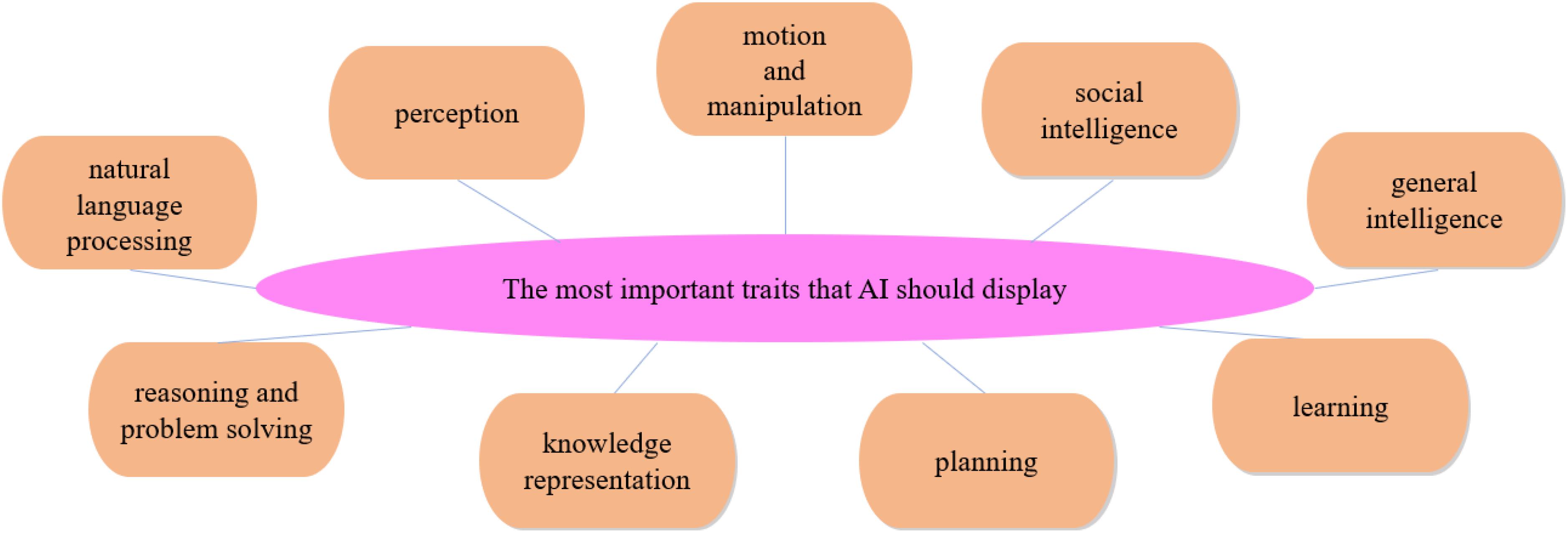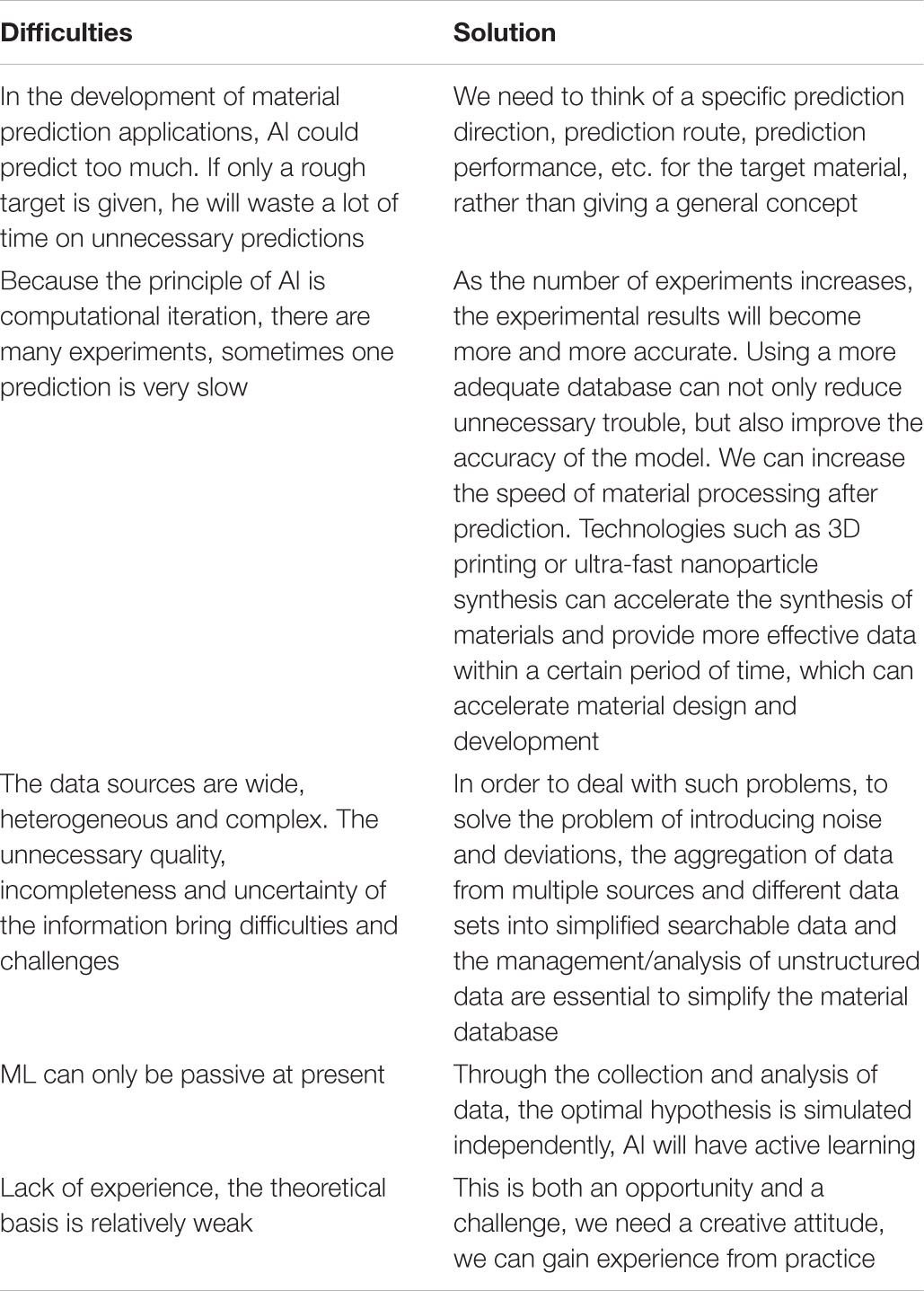Development Status and Prospects of Artificial Intelligence in the Field of Energy Conversion Materials
- 1Key Laboratory of Advanced Ceramics and Machining Technology, Tianjin Key Laboratory of Composite and Functional Materials, School of Materials Science and Engineering, Ministry of Education, Tianjin University, Tianjin, China
- 2National Engineering Laboratory for Risk Perception and Prevention, Beijing, China
- 3Materials Engineering, The University of Queensland, Brisbane, QLD, Australia
- 4School of Life Sciences, Tsinghua University, Beijing, China
With the characteristics of high-speed calculation and high-accuracy prediction, artificial intelligence (AI) which also known as machine intelligence, including deep learning, machine learning, etc., have shown great advantages in cross-field applications. In material science field, AI can be used to discover new materials and predict corresponding critical properties. At present, AI has been used in the exploitation of energy conversion materials and other energy-related materials. In this review, we summary the current achievements of AI applications in energy conversions, analyze the advantages and disadvantages of AI techniques in material researches and point out future development prospects.
Introduction
The development of materials can be divided into four stages. “Material 1.0” begins from the Bronze Age in 3500 BC to the Iron Age and Steel Age. With the in-depth study of material physics and chemistry, we establish and develop electrodynamics, the quantum theory, Maxwell’s equations etc. Thus, materials entered the period called “Material 2.0.” “Materials 3.0” is calculating and computerized material science. In this period, material with target functionalities is computationally designed based on employing principles of physics and quantum chemistry (Li, 2008; Lefkidis and Hübner, 2015; Dildar, 2018; Muhammad, 2018; Chen D. et al., 2019). In the above stages, the cycle of a new material from research and development to market is long, which usually takes years or decades. To shorten the development cycle, material scientists start to apply artificial intelligence (AI) techniques to accelerate material discovery, which means we are entering the age of “Material 4.0” (Butler et al., 2018) “Materials 4.0,” also known as Materials Big Data Informatics (Xue, 2014; Xu Y., 2018), enables the research of new materials, including prototype project, performance testing, verification, and lifecycle assessment to be carried out in a virtual lab. Thus, we can hugely shorten the time that a new material need to manufacture and promote the application of new materials.
Artificial intelligence can be regarded as machines (with different algorithms) with the capacity to simulate “cognitive” functions of mankind, for example solving problems and learning (Alexander, 1998; du Boulay, 2001; Russell and Norvig, 2002; Legg and Hutter, 2007; Kaplan and Haenlein, 2018). The algorithm is a set of clear instructions that a machine or computer can execute (Anderson et al., 1984; Hasperue, 2015). Traits or capabilities that researchers expect an intelligent system to display includes knowledge representation, reasoning and problem solving, planning (Luger, 2005), perception, natural language processing, learning, motion, and manipulation (Russell and Norvig, 2002), social intelligence (Scassellati, 2002), and general intelligence (Pennachin and Goertzel, 2007). According to the type and amount of available data, AI can be divided into three types, namely the supervised, semi-supervised and unsupervised (Vluymans et al., 2015). The basic workflow and development process are shown in Figure 1. The input and output data used for training supervised learning are known and massive, whose purpose is developing a function that reflects the relationship between the input and output data.
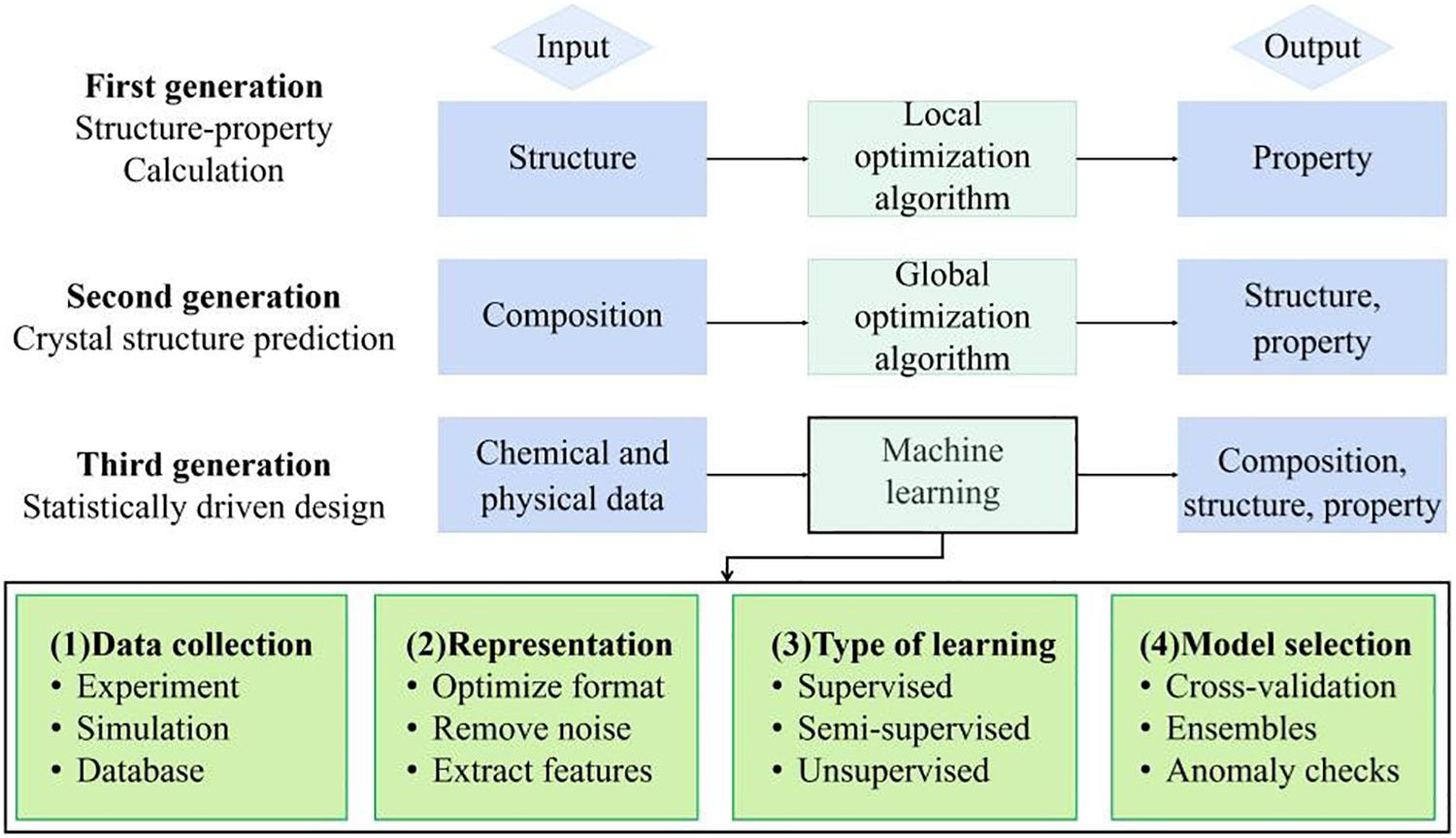
Figure 1. Evolution of the research workflow in computational chemistry from Butler et al. (2018).
Artificial intelligence is actually a simulation of the information process of human consciousness and thinking. The characteristics required for an intelligent system are shown in Figure 2. As we know, AI can solve problems basically because three processions. AI has sensory elements, which are used to recognize the state of the surrounding environment. It has motion elements, which react to the outside world. It also has thinking elements, which can think about what actions to adopt based on the information obtained by the sensory elements. This makes AI act like a human with excellent learning ability and huge knowledge and data. Thus, it can be used in various fields like security, healthy, finance, and research.
Due to excessive use of fossil fuels, energy crisis and environmental problems are growing worse and worse. New reusable energy substitutions are required, such as solar energy and tidal energy. Effective and clean energy conversion materials (Chen Z. et al., 2019; Zhang et al., 2020) are critical to boost the development of new energy sources. However, developing high-efficiency energy conversion materials (Zong et al., 2019) is labor-intensive and time-consuming. It is hard for materials researchers to explore exhaustively (Cheng et al., 2020). Recently rising AI techniques can be applied to discover various materials and boost the development of novel energy conversion materials. AI technologies influence material science mainly through automating specific research tasks via ML algorithms. Knowledge discovery in materials science can be hugely accelerated by integration of numerous and complementary AI techniques, such as Maximum Likelihood, planning, reasoning, search, and knowledge representation (Gomes et al., 2019).
Artificial intelligence can not only predict the performance of materials, but also has many applications in energy use. At present, AI has been successfully applied to the smart grid. AI technology can collect and integrate real-time information from different sensors and computers, and learn autonomously from patterns and anomalies in large data sets, so that it can make timely and effective decisions, Rationally allocate resources. Google’s recent application of AI technology has been proven to improve the efficiency of electricity management. It estimates the efficiency of the data center, improves the cooling system, and manages the equipment more effectively according to its machine learning (ML) algorithm estimates. Electricity reduction by 15% has saved Google hundreds of millions of dollars in a few years. AI can also be used for the prediction of clean energy (Zhang, 2016). IBM plans to launch a new product called “Deep Thunder.” This product will provide accurate weather forecasts with a resolution of 0.2 miles to 1.2 miles. It integrates a variety of predictions. The model collects a large number of data sources related to weather, environment, atmospheric conditions, and the operation of solar power plants and power grids, thereby using AI to optimize clean energy applications. AI will bring an all-round revolution in the energy field.
In this review, we first briefly survey the broad application of AI techniques. Then we review the current achievements of AI applications in energy conversion. At the end of the review, the advantages and disadvantages of AI techniques in materials research are analyzed, as well as the prospects on challenges and opportunities.
AI Application in Energy Conversion Materials
AI in Optoelectronic Materials
In recent years, AI has made continuous progress in the prediction of energy conversion materials such as solar energy conversion. There are many methods of converting solar energy and one is the thermal effect of light. The volt effect of light can also be used to convert solar radiation into electricity directly. The photovoltaic use of solar energy has become the fastest-growing research area in recent years. The research and development of solar cells has also increased rapidly. How to determine the most effective optoelectronic material is always a big problem that need to be solved urgently. Considering the huge amount of possible materials, it is very complicated to comprehensively assess all candidate materials and complete screening. However, the emergence of ML provides such an opportunity to use the existing database for virtual material screening and use the power of AI to accelerate the identification of materials with required characteristics. Applying AI approaches can increase the efficiency of the material processing via modeling and optimization (Figure 3). In the following part, we take the application of AI techniques in the field of energy catalysis as an example.
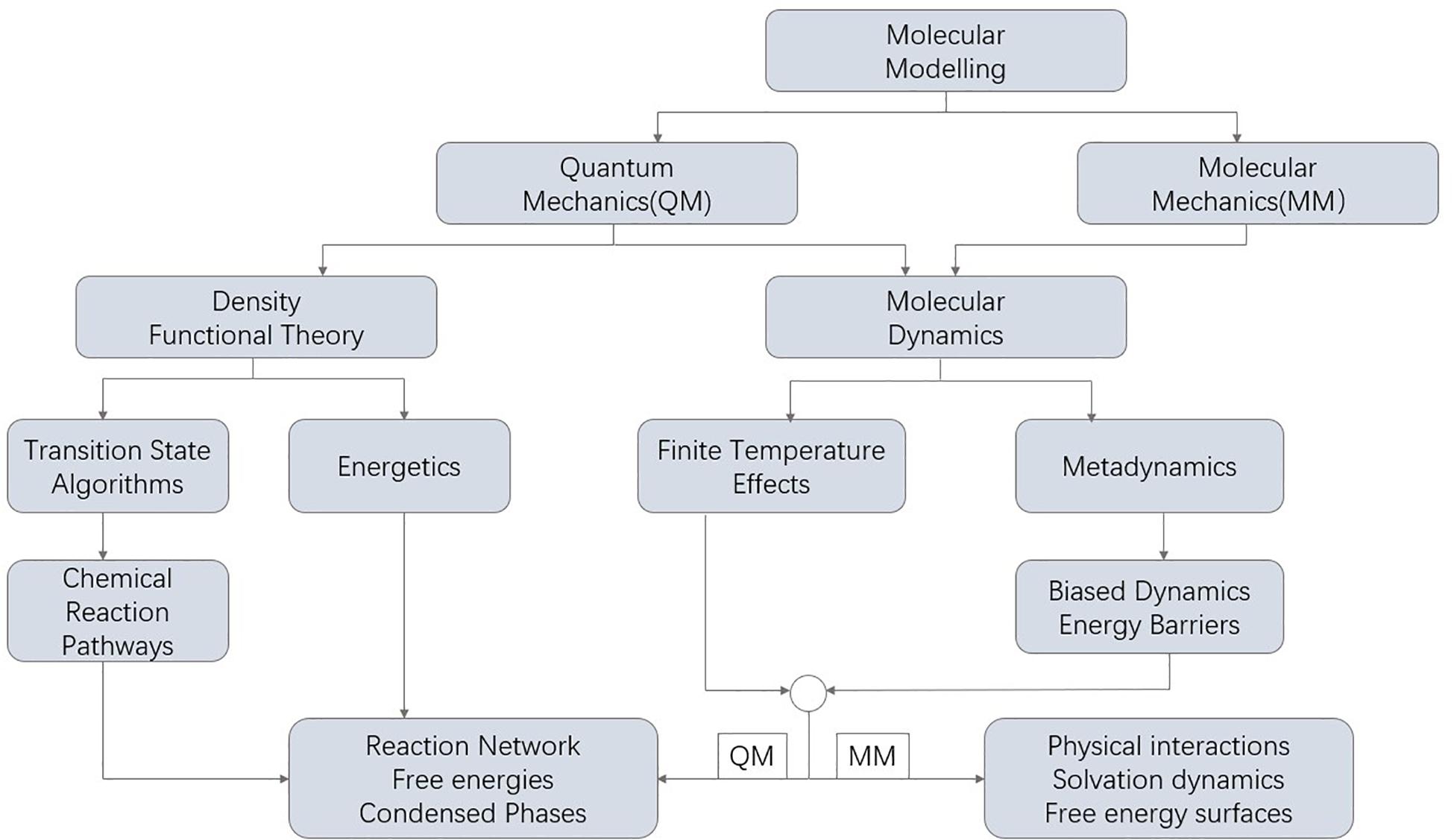
Figure 3. Classification of molecular modeling methods and its applications in the field of catalysis.
In 2016, Taylor Moot’s team (Moot et al., 2016) discovered that perovskite-type lead titanate (PbTiO3) is the most promising new photocathode material after virtually screening 50,000 types of known inorganic compounds through a material information-driven way. They has designed a new photocathode material for dye-sensitized solar cells (DSSC). The resulting PbTiO3 has great differences with the traditional photocathodes. It has excellent performance in aqueous solution, and its filling factor is very high when comparing with the typical photocathode system.
In this study, his team used the known p-type photocathode, such as NiO, Co3O4 etc., as reference materials, and used the chemical similarity measurement formula to calculate the similarity coefficient (Tc) between the chemical substances A and B. And the chemical similarity is proposed based on the theory of “similarity principle.” We can learn from it that molecules with similar structure may possess similar characteristics. Only based on structural similarity is far less-sufficient for the identification of materials. So Taylor et al. have improved the method of identifying materials. They believe that the structural similarity of electronic bands can identify new materials with required characteristics better. They compared materials that of known materials to find materials with similar crystal structures through knowledge-driven method.
Secondly, an important work to be done during the searching for materials with the same characteristics using knowledge-driven approach is the quantification of similarity. A unique descriptor is needed to define material characteristics. Taylor’s team discretized the band diagram of the material and used a 32-bit vector as representation. Each Brillouin area has a particular set of highly symmetrical points which collectively generate a B-fingerprint based on the symmetry. Firstly, the energy band structure of known materials is calculated using density functional theory and converted into the material descriptor (B fingerprint). It is believed that materials with good property can be implicitly encoded in the B fingerprint descriptor. The band structure data of over 40000 kinds of material were extracted from the AFLOWLIB database, and ML was used to determine the material that has the highest goodness of fit with the target characteristics.
The experimental results indicate that using virtual screening, we can identify the materials that have analogical electronic band structures and different crystal structures or elemental compositions. The team analyzed the performance of PbTiO3 DSSC. The test of PbTiO3 is a good representation to demonstrate how a non-obvious but promising new material can be identified through materials informatics successfully.
Training ML models to predict material properties directly can not only improve the screening process, but also design the relevant components of the material directly. Thus, materials that haven’t been explored previously can be preferentially used for experimental research. This team’s experiments validated the powerful usages of descriptors, which makes it possible to apply virtual screening methods to identify various materials in large databases quickly and efficiently.
The experimental results indicate that using virtual screening, we can identify the materials that have analogical electronic band structures and different crystal structures or elemental compositions. The team analyzed the performance of PbTiO3 DSSC. The test of PbTiO3 is a good representation to demonstrate how a non-obvious but promising new material can be identified through materials informatics successfully.
Training ML models to predict material properties directly can not only improve the screening process, but also design the relevant components of the material directly. Thus, materials that haven’t been explored previously can be preferentially used for experimental research. This team’s experiments validated the powerful usages of descriptors, which makes it possible to apply virtual screening methods to identify various materials in large databases quickly and efficiently.
Another application example in the field of solar energy transformation with the help of ML was completed by Sun et al. (2019). This team also focuses on the research and development of organic photovoltaic (OPV) cells. The most important part of this research and development process is still the design and synthesis of photovoltaic materials. Besides, the characterization, assembly and optimization of photovoltaic cells also matter. However, a large number of experimental cycles are needed while using traditional methods. The tedious experimental steps and strict synthesis conditions make the development efficiency of OPV extremely slow.
Basically, same as Taylor team’s research and development ideas, this team use computing tools provided by ML to extensively predict material properties. which can provide a large database and extract the relationships between various elements based on similarity search. Therefore, there is no need to have a basic understanding of the chemical and physical knowledge related to the characteristics, which saves a lot of resources and time.
This team collected 1,719 kinds of materials that can be used as OPV from existing literature as a database, including both polymers and small molecules, which can make the obtained models more versatile. Using deep learning in advanced ML algorithms can extract features from the images of chemical structures. The distribution of database information related to the OPV donor material database is shown in Figure 4A, and the schematic diagram of molecular expression is shown in Figure 4B. However, the accuracy of experiment results is not ideal. The main reason is that the number of samples in the database is too small, which means it is too difficult to get enough information to achieve high accuracy. Thus, it’s impossible to achieve fully trained deep learning models. In addition, the input of ML also includes two descriptors with different data sizes and seven types of molecular fingerprints, which is easy for the machine to access and predict PCE.
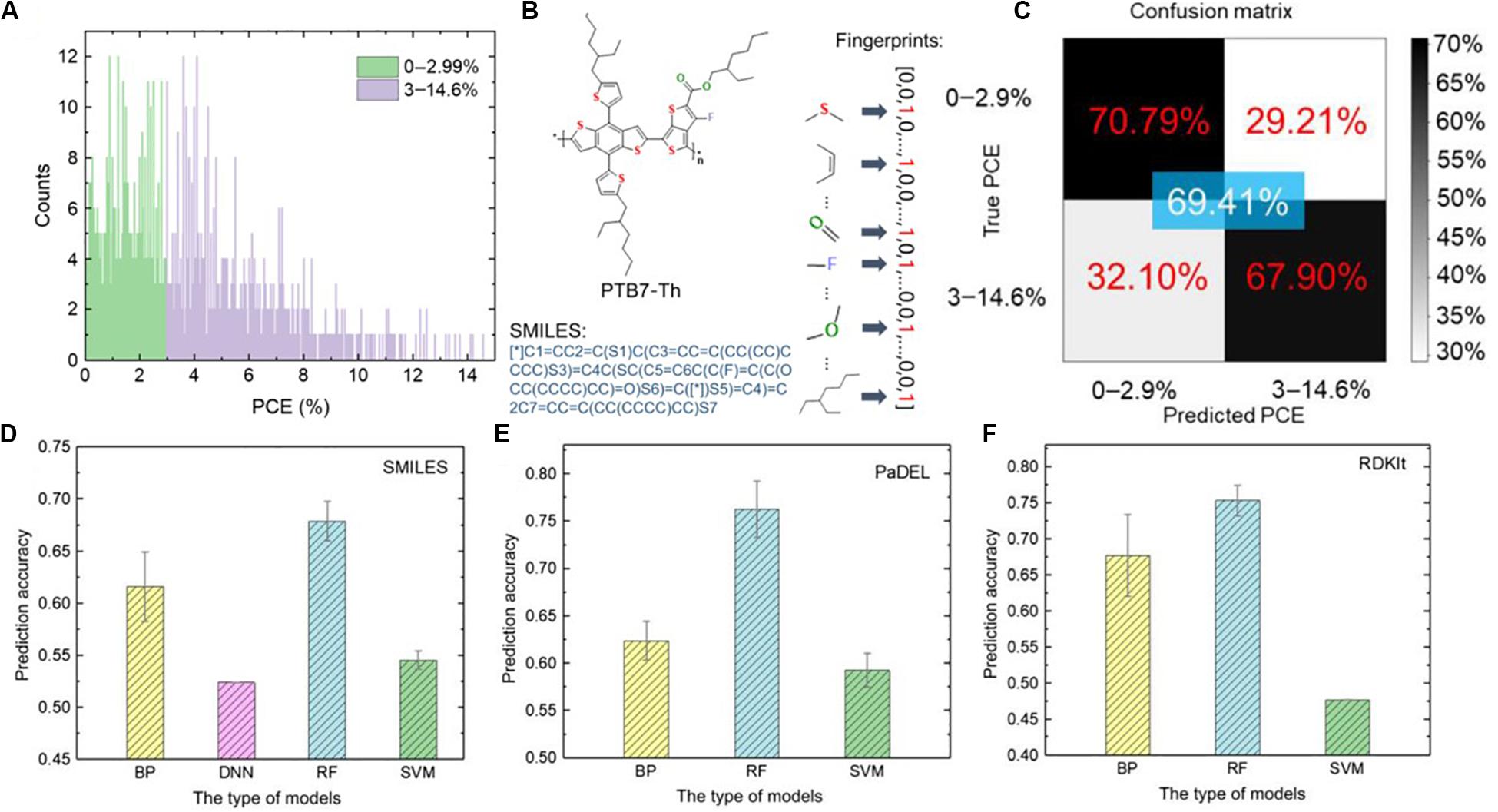
Figure 4. (A) Distribution of PCE molecules in the database. (B) Schematic representation of molecules. (C) Testing of the deep learning model using images as input. (D–F) Testing results of different ML models using descriptors as input. Reproduced from Sun et al. (2019) with permission from Copyright Scientific Publishers.
In summary, this team used four ML methods to screen donor materials from a large amount of data to effectively predict PCE of materials. Figure 4C is the test of the deep learning model in which the image is used as input. After that, the team conducted further experimental research on materials with excellent characteristics. Figures 4D–F shows the results of testing different ML models using SMILES, PaDEL, and RDKIt descriptors as inputs, respectively. Also, the research of the connection between the molecular chemical structure of OPV and PCE can speed up the design of new donor materials. Thus, the development of high PCE and OPV can be accelerated.
Sahu et al. (2018) used AI to build a model in a similar way, which can effectively predict the efficiency of organic photovoltaic (OPV) based on its composition. They construct PCE prediction model with using 13 important microscopic properties of organic materials as descriptors. The experimental data obtained is shown in Figure 5, among them, (a,c) show that correlations of FF and PCE versus ΔH, (b,d) show that correlations of FF and PCE versus ΔL, (e,f) verified the theoretically predicted relationship between the PCE of the test set (30 molecules) and the experimental PCE, and all data points using the leave-one-out cross-validation technique for the GB model. It describes the importance of descriptors for GB (g) and RF (h) models. (i) and LUMO (j) to the most important electronic transition versus ΔH and ΔL, respectively. Percentage of donor molecules (PDonor) versus POrb in cases of occupied (k) and unoccupied (l) orbitals are depicted. The above results in Figure 5 indicate that it can be applied to high-throughput virtual screening of excellent new donor molecules for high-efficiency OPVs, and greatly saves calculation and time.
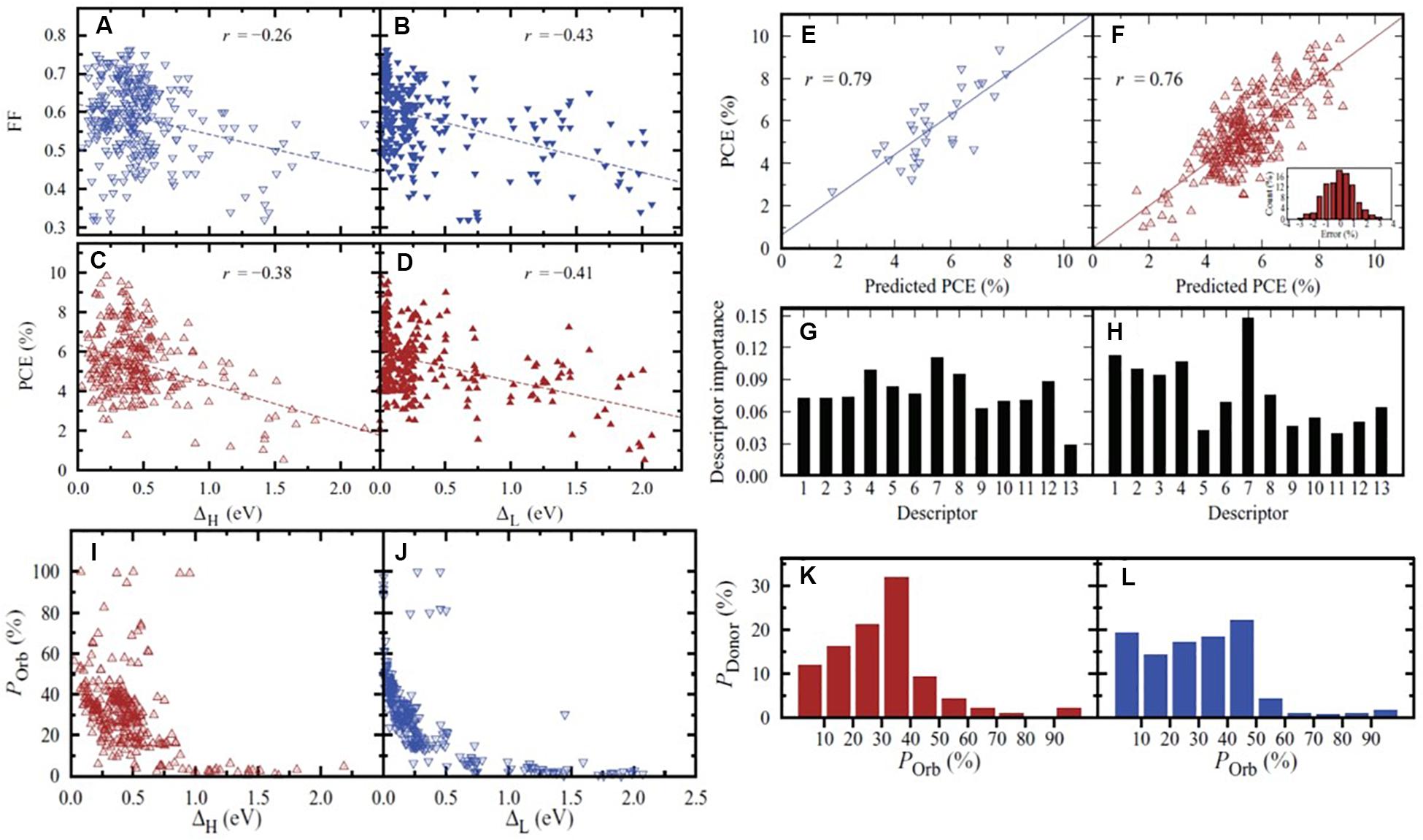
Figure 5. (A,C) Correlations of FF and PCE versus ΔH. (B,D) Correlations of FF and PCE versus ΔL. Theoretically predicted versus experimental PCE for the testing set (30 molecules) (E) and all data points using the leave one out cross validation technique (F) for the GB model. It describes the importance of descriptors for GB (G) and RF (H) models. (I) and LUMO (J) to the most important electronic transition versus ΔH and ΔL, respectively. Percentage of donor molecules (PDonor) versus POrb in cases of occupied (K) and unoccupied (L) orbitals are depicted. Reproduced from Sahu et al. (2018) with permission from Copyright WILEY-VCH Verlag GmbH & Co., KGaA, Weinheim.
The combination of AI and experimental methods makes AI an effective auxiliary tool to guide experiments. AI has very promising development prospects in evaluating large quantities of materials and predicting material properties quickly.
AI in Hydrogen Peroxidation Catalysts
The electrochemical method which partially reduces O2 to H2O2 (O2 + 2H/e– → H2O2) is an effective way to produce hydrogen peroxide. However, since different proportions of the adsorption reaction intermediate can affect the balance between the activity and selectivity of the catalyst. High activity tend to occur the four-electron oxygen reduction reaction (ORR), which resulted in low selectivity. Therefore, we urgently need to develop an electrocatalyst with both high activity and selectivity for hydrogen peroxide. Guo et al. (2019) screened a single-atom catalyst (SAC), and further used ML technology to explore the activity and selectivity of SAC (Figures 6A–E). The proportional relationships between the ΔG(O∗) and BM-O is shown in Figure 6D, and the proportional relationships between the ΔG(OOH∗) and COOH∗ is shown in Figure 6E. Figure 6A shows the variations of ΔG(O∗) and ΔG(OOH∗) on the 31 studied SACs. And Figures 6B,C show the weight of four variables in O∗ (b) and OOH∗ (c) adsorption, respectively. They spin-polarized DFT computations were performed using the Vienna ab initio simulation package (VASP) and built a ML model, selected eight feature descriptors, including d/p orbital electron number (edp’), oxide formation enthalpy (Hf.ox) (O’Connor et al., 2018), electronegativity (Nm), electron affinity (Am) and the first ionization energy (Im) of the central atom, the number of coordinated N atoms (Nn), the electrons negative sum (SNm) and distance ratio (Rd) of adjacent C and N atoms to explore the relationship between ΔG (O∗) and the intrinsic descriptor of the SAC catalyst. The comparison between DFT and predicted ΔG(O∗) values is shown in Figure 6F, and random forest model’s feature importance for ΔG(O∗) is shown in Figure 6G. ML reveals the reasons for the difference between selectivity and activity of SAC and guides the discovery of a more stable and efficient SAC for the production of hydrogen peroxide. It can be seen that ML can greatly help to establish the relationship between material structure and properties.
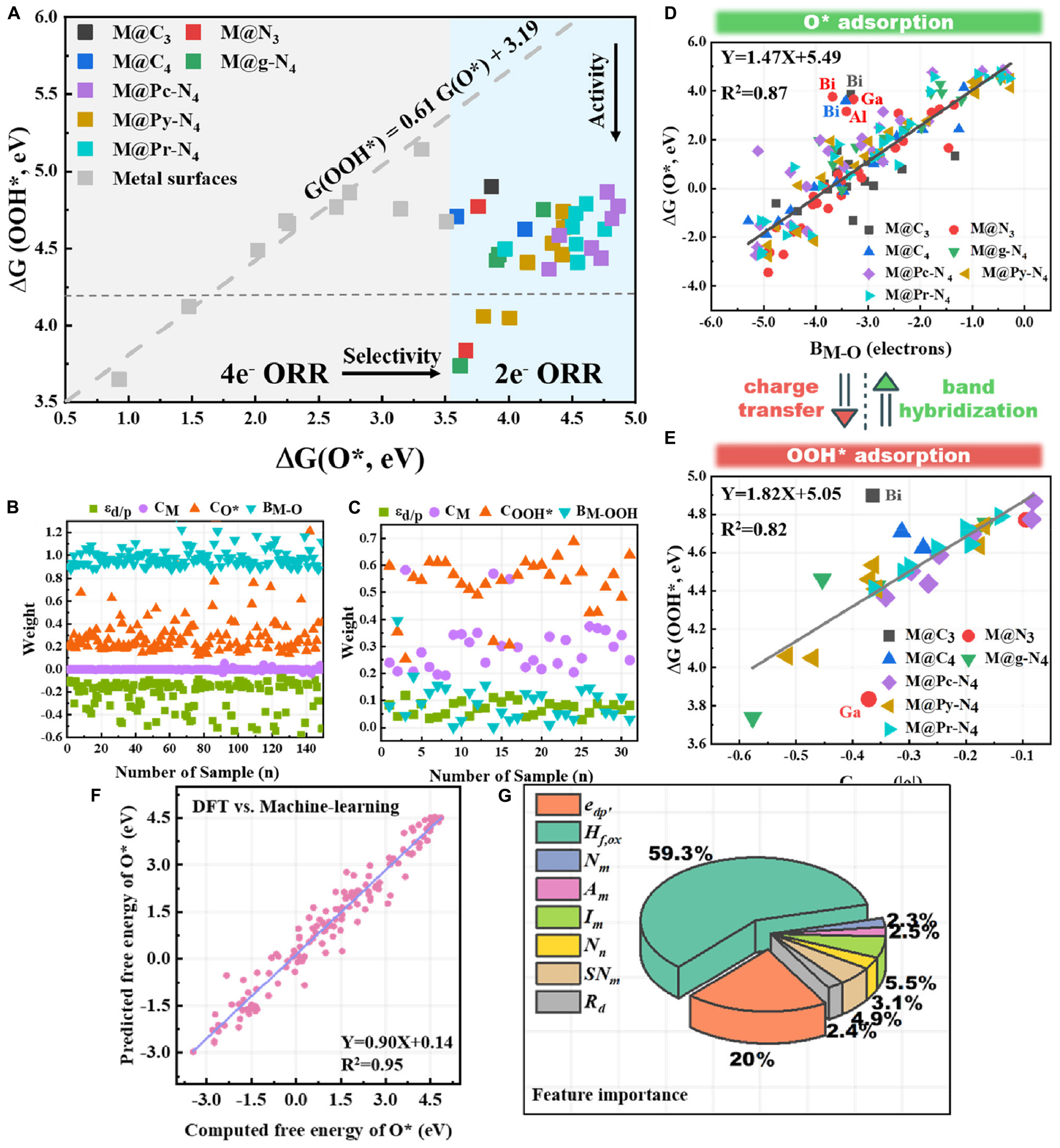
Figure 6. (A) Variations of ΔG(O*) and ΔG(OOH*) on the 31 studied SACs. (B) and OOH* (C) adsorption. (D) The proportional relationships between the ΔG(O*) and BM-O. (E) The proportional relationships between the ΔG(OOH*) and COOH*. (F) Comparison between DFT and predicted ΔG(O*) values. (G) Random forest model‘s feature importance for ΔG(O*). Reproduced from Guo et al. (2019) with permission from Copyright (2019) American Chemical Society.
Transition metal sulfide (TMDC) has been widely used in solar batteries, lithium ion batteries and catalysts (Wang et al., 2012), which have good electrical conductivity and catalytic performance. But they do not perform well in the electrocatalytic process of OER\HER. Ge et al. (2020) tried to predict the structure of new materials by optimizing the descriptor and combining density functional theory.
Ge et al. (2020) used LASSO algorithm to select characteristic descriptors and proposed the prediction equation of catalytic performance. That dramatically improved performance may be achieved by combining two independent TMDC while optimizing such descriptors as rotational angle, bond length, distance between layers, and the ratio of the bandgaps of two component materials can provide. Thereby, they avoided complex experiments or expensive DFT calculations. Subsequently, it becomes easier to predict the catalytic performance of HER/OER in TMDC heterostructures. Relying on ML technology, we could save a lot of time and cost for material performance prediction and structure modification. Figure 7A is Schematic diagram of the 0°-rotated heterostructure MoS2/WS2 configurations for overall water splitting. Purple represents the atom of Mo, yellow represents the atom S, and blue represents the atom W, respectively. Figures 7B,C shows the linear relationship between adsorption free energy (b)ΔG∗OH and (c)ΔG∗O and ΔG∗OH. Figures 7D,E shows the HER and OER overpotential between different materials. The team found that, by rotating the heterojunction structure, the catalytic performance can be significantly improved. When the rotation angle is 300°, both ηHER and ηOER will reach their optimal state. This is the best performance of water catalyst they discovered so far.
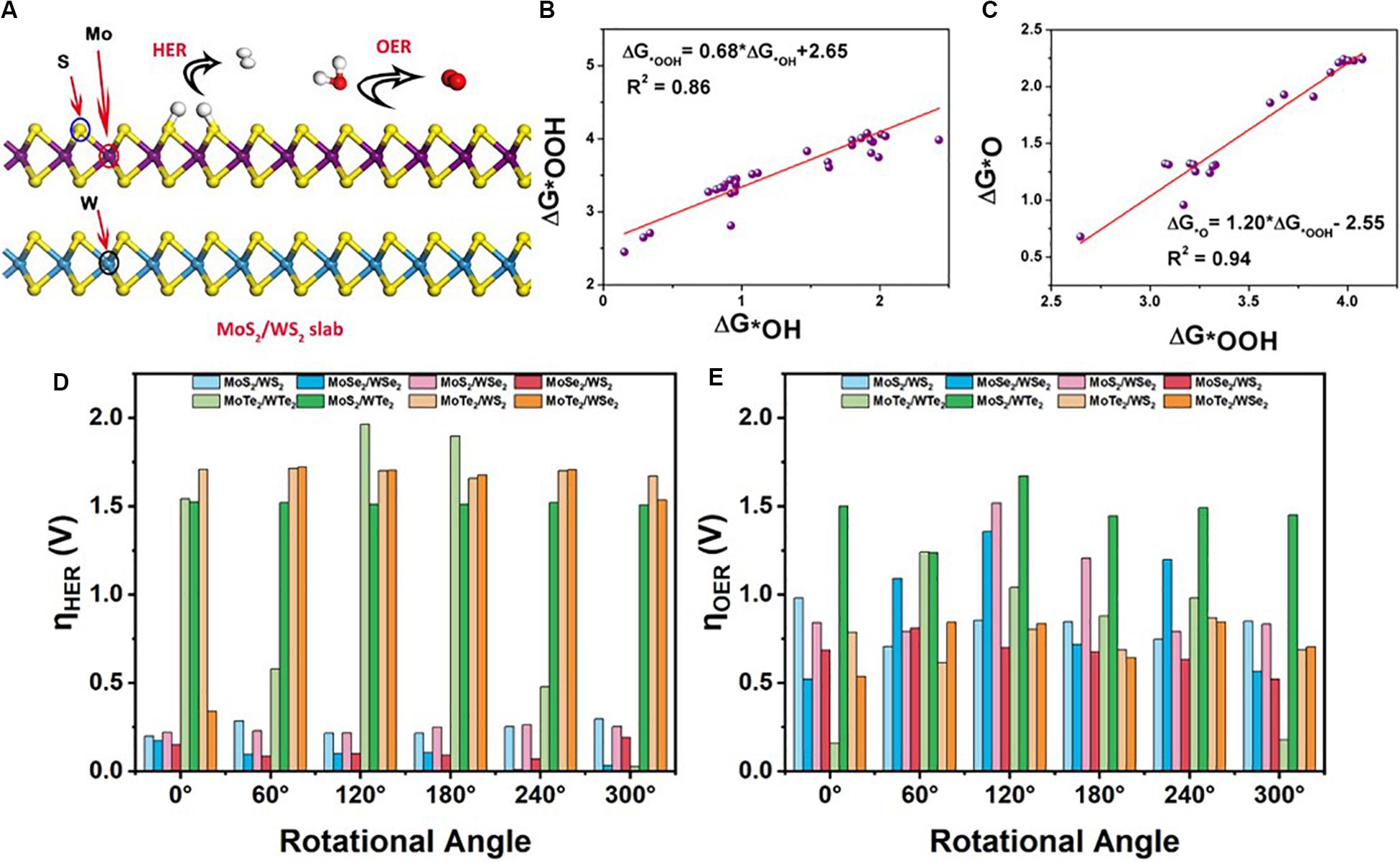
Figure 7. (A) Schematic diagram of the heterostructure configurations for overall water splitting. (B,C) The linear relationships between adsorption free energies. (D,E) The relationships of the rotational angle with ηHER and ηOER for each system. Reproduced from Ge et al. (2020) with permission from Copyright (2020) American Chemical Society.
Similarly, in order to develop a highly active and highly selective electrocatalyst for oxygen reduction and oxygen release, Liu et al. (2020) summarized the method of designing accurate descriptors, and found varieties of Descriptors can improve the ability to predict material properties by ML and high throughput computing to develop new and different catalytic materials.
AI in Water Electrolysis Catalysts
The energy crisis and environmental problems are getting worse and worse, fossil fuel storage is decreasing. Thus, hydrogen plays an increasingly important role as the cleanest renewable energy source. At present, water electrolysis is the most effective method to produce hydrogen. But the cathode materials require mostly expensive metals, which are not suitable for large-scale applications. This promotes people to look for other cathode materials with rare earth-rich elements. NixPy with good stability and high activity has excellent hydrogen release reaction potential and has great development prospects. However, its crystal surfaces have diverse active sites, resulting in the difficulty to understand the reactions at the atomic level. Hu et al. (2019) used Artificial Neural Networks and Support Vector Machine to explore the properties at the atomic level, and established a clear relationship between the active site and the bond length properties at the atomic scale. During the calculations, self-consistent periodic DFT was adopted by generalized gradient approximation with Perdew-Burke-Ernzerhof exchange-correlation functional. The plane-wave ultrasoft pseudopotential method, describing the ionic cores of Ni-3d84s2and P-3s33p2, were represented the electron-ion interaction in reciprocal space. The Broyden–Fletcher–Goldfarb–Shanno (BFGS) scheme was selected as the minimization algorithm. The results shown in the Figure 8 provide guidance for the synthesis of NixPy, greatly reducing the calculation cost and providing approaches to develop highly catalytically active materials.
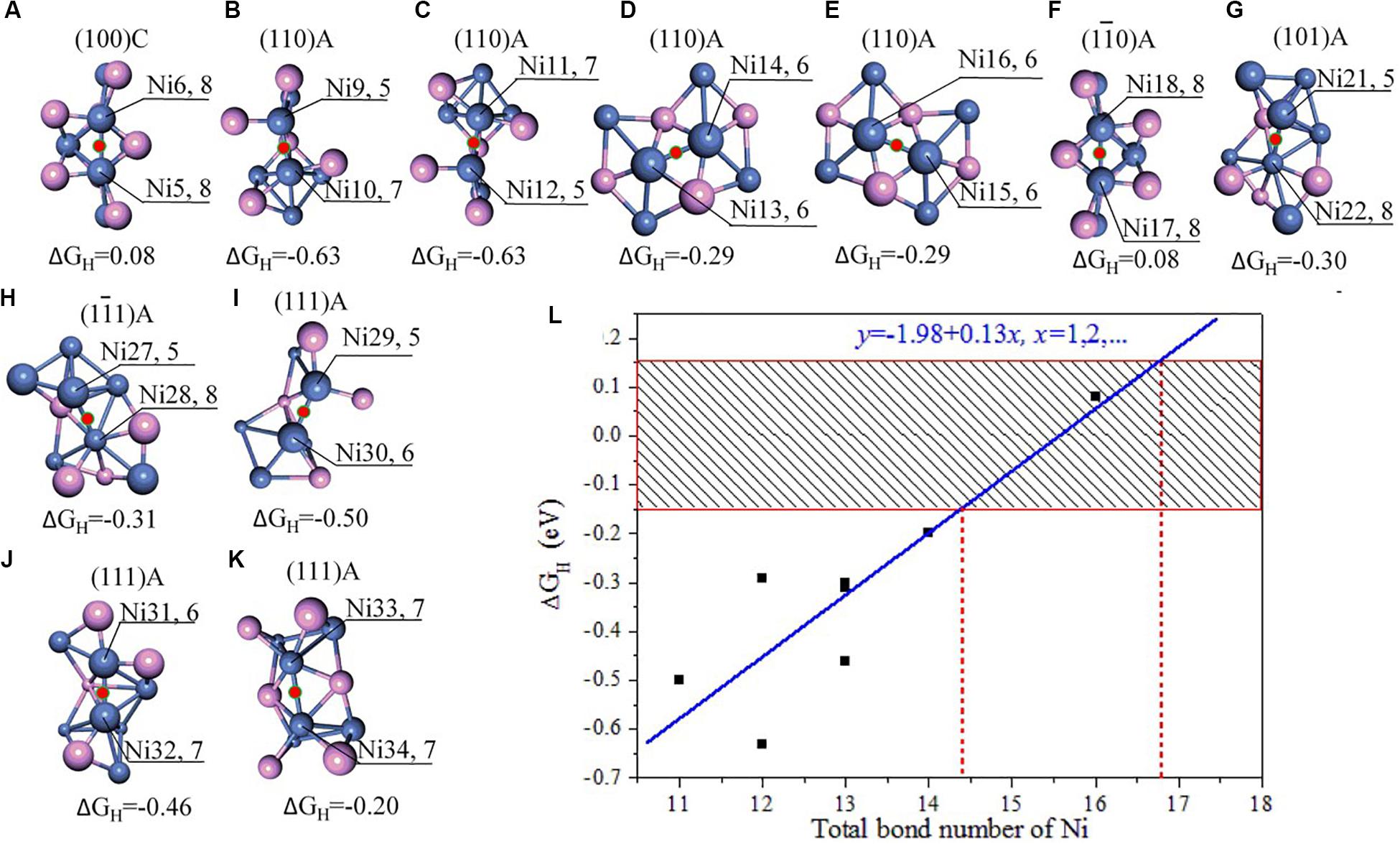
Figure 8. (A–K) Stable adsorption sites with bridge NiNi. (L) the relationship between the bond number of Ni and 1GH. Reproduced from Hu et al. (2019) with permission from Copyright Frontiers Media S.A.
In this study of Prof. Regina Palkovits (Palkovits and Palkovits, 2019) on water oxidation catalysts, AI has also performed well. In their study, the integrated use of artificial neural networks (ANNs, which is a kind of imitation animal neural network behavior characteristics, the algorithm of distributed parallel information processing mathematical model) and other kinds of AI algorithms, and adopt the method of ML to evaluate performance and to predict (Figure 9A), and using Pandas package implements visualization processing of experimental data from the data graph, an unsupervised algorithm is adopted for data (Figure 9B) is used to reveal some of the structure of the data set. Figures 9C,D shows the outcome of the training.
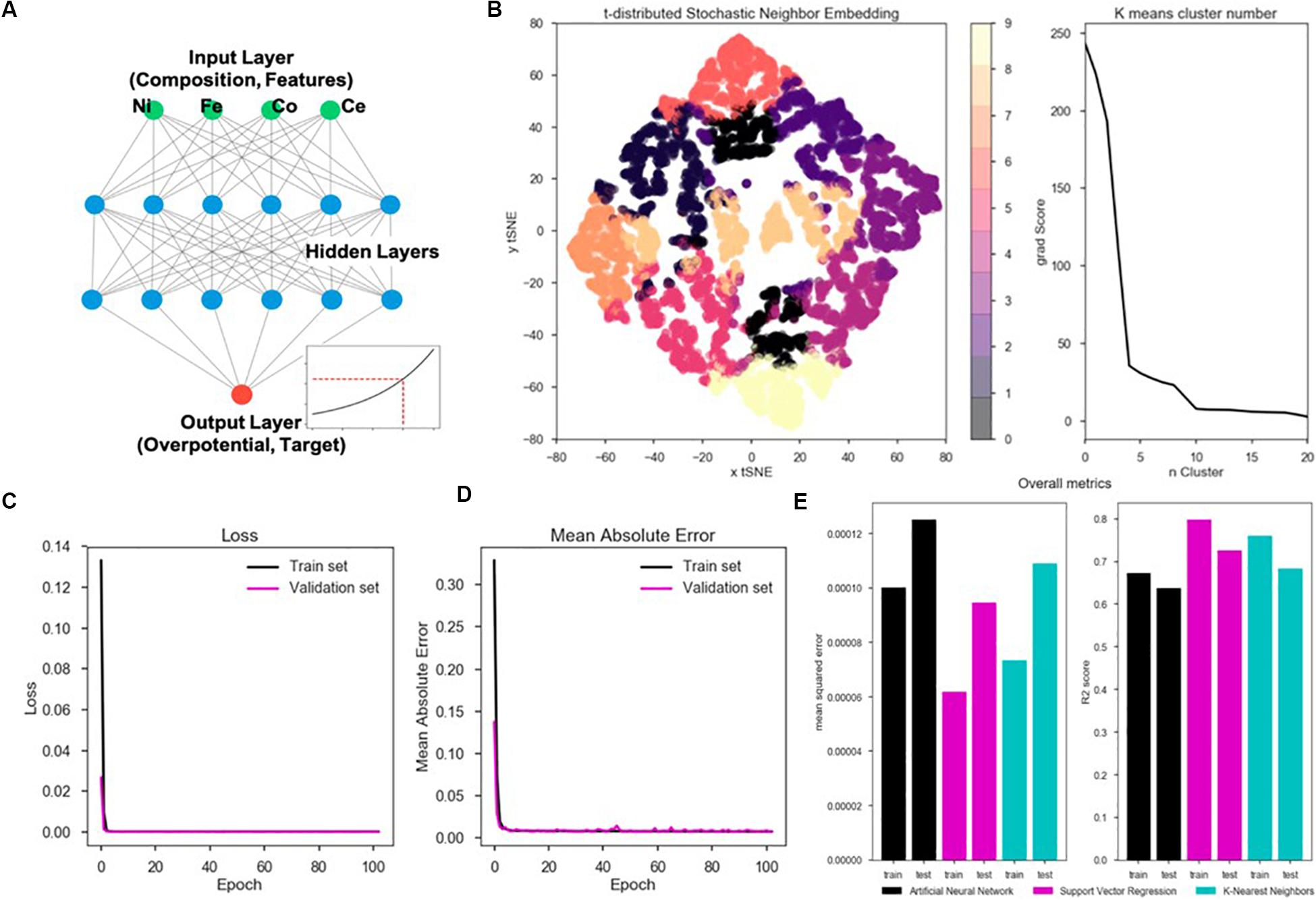
Figure 9. (A) The operation mode of artificial neural network. (B) Unsupervised visualization of the data sets features with k-means clustering (right) and t-distributed stochastic neighbor embedding (left). (C,D) Loss and mean absolute error metrics of the used ANN plotted over the calculated epochs for the training set (black) and the validation set (magenta). (E) Metrics overview for all methods. Reproduced from Palkovits and Palkovits (2019) with permission from Copyright (2019) American Chemical Society.
Then, they used three different ML models (Figure 9E) to train and predict the electrochemical data set, arrange and transform the data, apply them to supervise the learning algorithm, and evaluate the three methods based on the test data. Their experimental work shows that using more complex models does not necessarily lead to more accurate prediction results, and the accuracy of the models is related to the data itself.
AI in Microbial Fuel Cells
The increasingly serious environmental problems have caused harm to human health and survival, so the research and development in the field of biotechnology has become the focus. Among them, the development of cheap, simple and efficient biosensors is the key difficulty. Mathematical models can be used to describe the MFC biofilm formation process and the physicochemical effects, but when simulating complex environments such as mixed microbial communities, the parameters involved cannot achieve the expected results. With the development of AI, ML, which can quickly process data and accurately build models, is increasingly used in MFCS. Lesnik’s (Lesnik and Liu, 2017) team used artificial neural networks to predict microbial fuel cell biofilm communities and bioreactor performance. The Shi’s (Xu G., 2018) team used a stacked denoising automatic encoder (SDAE) deep learning network to predict the performance of a two-stage biofilm system based on traditional anaerobic/aerobic processes. Cai’s (Cai et al., 2019) team used GLMNET, RF, XGBOOST, NNET, KNN, and radial kernel support vector machine algorithms to classify substrate types from genomic datasets. The Mostafa Ghasemi’s (Ghasemi et al., 2020) team uses fuzzy modeling techniques as modeling techniques and particle swarm optimization (PSO) algorithms to determine the best operating parameters to improve the performance of MFC. It can be seen that the role of ML technology in the field of biotechnology will become more and more important.
Conclusion and Perspective
The application of AI in the field of materials, first of all, overcomes the requirements of high experimental conditions to a certain extent and makes up for the weakness of the existing theoretical foundation. It can directly analyze and predict the properties and microstructures of materials and discover new types of material. AI can make up for the limitations of human ability to analyze and process materials. Secondly, AI can reduce the material development cycle and shorten the time required for commercialization (Jose and Ramakrishna, 2018; Wang et al., 2019). In the past, researchers need to read through hundreds and thousands of relevant papers to adjust and improve experimental parameters. They can only rely on manual classification and summary to screen materials with required characteristics, which consumes a lot of labor and time. Applying AI approaches increase the efficiency via modeling and optimization without increasing the cost (Zalesny, 2017; Bin Janai et al., 2018; Kaneko et al., 2019). Hence, AI technology plays a significant role in energy conversion and other fields.
The main challenges for the application of AI in the field of materials prediction lies in the following aspects:
(1) In the development of AI application for materials prediction, how can we choose appropriate features to promote the further application efficiency of AI.
(2) Since the principle of AI is computational iteration, experimental results can be more accurate with more iterations. With more adequate the database, the model accuracy can also be enhanced. Technologies such as 3D printing or ultra-fast nanoparticle synthesis (Chen et al., 2016a, c; Chen Y. et al., 2019) can accelerate the synthesis of materials, and supply more effective data within a certain period of time (Chen et al., 2016b, 2017). This can accelerate the design and development of materials.
(3) The sources of the data are wide, heterogeneous and complex. The unwarranted quality, incompleteness and uncertainty of the information present difficulties and challenges. How to properly handle the problem of uncertainty, solve the problem of introducing noise and bias, aggregate data from multiple sources and different data sets into simplified searchable data, and manage/analyze unstructured data are vital to simplify the database of materials.
(4) In addition, current ML can only passively analyze the potential relationship of data. Active learning will become one of the future directions of ML (Wang et al., 2019), through the collection and analysis of data, the optimal hypothesis is simulated independently.
As a conclusion, AI is promising in material prediction. Although, there are still multiple challenges to be overcome. Summarize the above in the table below.
Author Contributions
XY and ZL were the first authors and completed the writing of the manuscript. ZH, YZ, ZX, WL, SL, HZ, SD, JX, and WH were the second authors and completed the grammar proofreading of the manuscript. YW and YD provided the key ideas and relevant scientific guidance. All authors contributed to the article and approved the submitted version.
Conflict of Interest
The authors declare that the research was conducted in the absence of any commercial or financial relationships that could be construed as a potential conflict of interest.
References
Alexander, B. (1998). The perplexing conclusion: the essential difference between natural and artificial intelligence is human beings’ ability to deceive. J. Appl. Philos. 15, 165–178. doi: 10.1111/1468-5930.00084
Anderson, J., Michalski, R. S., and Mitchell, T. M. (1984). Machine Learning, An Artificial Intelligence Approach. Burlington, MA: M. Kaufmann.
Bin Janai, M. A., LinWoon, K., and Chan, C. S. (2018). Design of efficient blue phosphorescent bottom emitting light emitting diodes by machine learning approach. Org. Electron. 63, 257–266. doi: 10.1016/j.orgel.2018.09.029
Butler, K. T., Davies, D. W., Cartwright, H., Isayev, O., and Walsh, A. (2018). Machine learning for molecular and materials science. Nature 559, 547–555.
Cai, W., Lesnik, K. L., Wade, M. J., Heidrich, E. S., Wang, Y., and Liu, H. (2019). Incorporating microbial community data with machine learning techniques to predict feed substrates in microbial fuel cells. Biosens. Bioelectron. 133, 64–71. doi: 10.1016/j.bios.2019.03.021
Chen, D., Li, S., Jie, J., Li, S., Zheng, S., Weng, M., et al. (2019). A descriptor of “material genes”: effective atomic size in structural unit of ionic crystals. Sci. China 62, 849–855. doi: 10.1007/s11431-018-9461-x
Chen, Y., Egan, G. C., Wan, J., Zhu, S., Jacob, R. J., Zhou, W., et al. (2016a). Yonggang Yao. Ultra-fast self-assembly and stabilization of reactive nanoparticles in reduced graphene oxide films. Nat. Commun. 7:12332.
Chen, Y., Fu, K., Zhu, S., Luo, W., Wang, Y., Li, Y., et al. (2016b). Reduced graphene oxide films with ultrahigh conductivity as Li-ion battery current collectors. Nano Lett. 16, 3616–3623. doi: 10.1021/acs.nanolett.6b00743
Chen, Y., Li, Y., Wang, Y., Fu, K., Danner, V. A., Dai, J., et al. (2016c). Rapid, in situ synthesis of high capacity battery anodes through high temperature radiation-based thermal shock. Nano Lett. 16, 5553–5558. doi: 10.1021/acs.nanolett.6b02096
Chen, Y., Xu, S., Li, Y., Jacob, R. J., Kuang, Y., Liu, B., et al. (2017). FeS2 Nanoparticles Embedded in Reduced Graphene Oxide toward Robust, High-Performance Electrocatalysts. Adv. Energ. Mater. 7:1700482. doi: 10.1002/aenm.201700482
Chen, Y., Xu, S., Zhu, S., Jacob, R. J., Pastel, G., Wang, Y., et al. (2019). Millisecond synthesis of CoS nanoparticles for highly efficient overall water splitting. Nano Res. 2, 1–9.
Chen, Z., Liu, Y., Liu, C., Zhang, J., Chen, Y., Hu, W., et al. (2019). Engineering the Metal/Oxide interface of Pd Nanowire@CuOx electrocatalysts for efficient alcohol oxidation reaction. Small 16:1904964. doi: 10.1002/smll.201904964
Cheng, J., Yang, X., Xuan, X., Liu, N., and Zhou, J. (2020). Development of an efficient catalyst with controlled sulfur vacancies and high pyridine nitrogen content for the photoelectrochemical reduction of CO2 into methanol. Sci. Total Environ. 702:134981. doi: 10.1016/j.scitotenv.2019.134981
Dildar, A. (2018). Theoretical Studies of Some Two-Dimensional Materials. Nanjing: Nanjing University of Science and Technology.
du Boulay, B. (2001). N.J. Nilsson, artificial intelligence: a new synthesis t. dean, j. allen and y. aloimonos, artificial intelligence: theory and practice d. poole, a. mackworth and r. goebel, computational intelligence: a logical approach s. russell and p. norvig, artificial intelligence: a modern approach. Artif. Intell. 125, 227–232. doi: 10.1016/s0004-3702(00)00064-3
Ge, L., Yuan, H., Min, Y., Li, L., Chen, S., Xu, L., et al. (2020). Predicted optimal bifunctional electrocatalysts for the hydrogen evolution reaction and the oxygen evolution reaction using chalcogenide heterostructures based on machine learning analysis of in silico quantum mechanics based high throughput screening. J. Phys. Chem. Lett. 11, 869–876. doi: 10.1021/acs.jpclett.9b03875
Ghasemi, M., Nassef, A. M., Al-Dhaifallah, M., and Rezk, H. (2020). Performance improvement of microbial fuel cell through artificial intelligence. J. Energy Res. 1–13. doi: 10.1002/er.5484
Gomes, C. P., Selman, B., and Gregoire, J. M. (2019). Artificial intelligence for materials discovery. MRS Bull. 44, 538–544.
Guo, X., Lin, S., Gu, J., Zhang, S., Chen, Z., and Huang, S. (2019). Simultaneously achieving high activity and selectivity toward two-electron o2 electroreduction: the power of single-atom catalysts. ACS Cata 9, 11042–11054. doi: 10.1021/acscatal.9b02778
Hasperue, W. (2015). The master algorithm: how the quest for the ultimate learning machine will remake our world. J. Comput. Sci. Technol. 15, 157–158.
Hu, J., Cao, X., Zhao, X., Chen, W., Lu, G., Dan, Y., et al. (2019). Catalytically active sites on ni5p4 for efficient hydrogen evolution reaction from atomic scale calculation. Front. Chem. 7:444. doi: 10.3389/fchem.2019.00444
Jose, R., and Ramakrishna, S. (2018). Materials 4.0: materials big data enabled materials discovery. Appl. Mater. Today 10, 127–132. doi: 10.1016/j.apmt.2017.12.015
Kaneko, M., Fujii, M., Hisatomi, T., Yamashita, K., and Domen, K. (2019). Regression model for stabilization energies associated with anion ordering in perovskite-type oxynitrides. J. Energ. Chem. 36, 7–14. doi: 10.1016/j.jechem.2019.01.012
Kaplan, A., and Haenlein, M. (2018). Siri, Siri, in my hand: who’s the fairest in the land? On the interpretations, illustrations, and implications of artificial intelligence. Bus. Horizons 62, 15–25. doi: 10.1016/j.bushor.2018.08.004
Lefkidis, G., and Hübner, W. (2015). “Using magnetic nanomaterials for logic function devices,” in Abstract Book of BIT’s 1st Annual World Congress of Smart Materials-2015, Busan.
Legg, S., and Hutter, M. (2007). A collection of definitions of intelligence. Comput. Sci. 157, 17–24.
Lesnik, K. L., and Liu, H. (2017). Predicting microbial fuel cell biofilm communities and bioreactor performance using artificial neural networks. Environ. Sci. Technol. 51, 10881–10892. doi: 10.1021/acs.est.7b01413
Li, J. (2008). “Recent developments in computational actinide chemistry,” in Proceedings of the 26th Annual Conference of the Chinese Chemical Society of Modern Nuclear Chemistry and Radiochemistry 中国化学会第26届学术年会现代核化学与放射化学分会场论文集, Tianjin.
Liu, J., Liu, H., Chen, H., Du, X., Zhang, B., Hong, Z., et al. (2020). Progress and challenges toward the rational design of oxygen electrocatalysts based on a descriptor approach. Adv. Sci. 7:1901614. doi: 10.1002/advs.201901614
Luger, G. F. (2005). Artificial Intelligence: Structures and Strategies for Complex Problem Solving. Boston, MA: Addison-Wesley.
Moot, T., Isayev, O., Call, R. W., McCullough, S. M., Zemaitis, M., Lopez, R., et al. (2016). Material informatics driven design and experimental validation of lead titanate as an aqueous solar photocathode. Mater. Discov. 6, 9–16. doi: 10.1016/j.md.2017.04.001
Muhammad, Z. (2018). Structural, Electronic and Magnetic Study of Zirconium-based 2D Materials. Hefei: University of Science and Technology of China.
O’Connor, N. J., Jonayat, A. S. M., Janik, M. J., and Senftle, T. P. (2018). Interaction trends between single metal atoms and oxide supports identified with density functional theory and statistical learning. Nat. Catal. 1, 531–539. doi: 10.1038/s41929-018-0094-5
Palkovits, R., and Palkovits, S. (2019). Using artificial intelligence to forecast water oxidation catalysts. ACS Catal. 9, 8383–8387. doi: 10.1021/acscatal.9b01985
Pennachin, C., and Goertzel, B. (2007). “Contemporary Approaches to Artificial General Intelligence,” in Artificial General Intelligence. Cognitive Technologies, eds B. Goertzel and C. Pennachin (Berlin: Springer), 1–30. doi: 10.1007/978-3-540-68677-4_1
Russell, S., and Norvig, P. (2002). Artificial Intelligence: A Modern Approach. Upper Saddle River, NJ: Prentice Hall.
Sahu, H., Rao, W., Troisi, A., and Ma, H. (2018). Toward predicting efficiency of organic solar cells via machine learning and improved descriptors. Adv. Energ. Mater. 8, 17480–17488.
Sun, W., Zheng, Y., Yang, K., Zhang, Q., Shah, A. A., Wu, Z., et al. (2019). Machine learning-assisted molecular design and efficiency prediction for high-performance organic photovoltaic materials. Sci. Adv. 5:eaay4275. doi: 10.1126/sciadv.aay4275
Vluymans, S., D’eer, L., Saeys, Y., and Cornelis, C. (2015). Applications of fuzzy rough set theory in machine learning: a survey. Fundam. Inform. 142, 53–86.
Wang, M., Wang, T., Cai, P., and Chen, X. (2019). Nanomaterials discovery and design through machine learning. Small Methods 3:1900025. doi: 10.1002/smtd.201900025
Wang, W.-N., An, W.-J., Ramalingam, B., Mukherjee, S., Niedzwiedzki, D. M., Gangopadhyay, S., et al. (2012). Size and structure matter: enhanced co2 photoreduction efficiency by size-resolved ultrafine pt nanoparticles on TiO2 single crystals. J. Am. Chem. Soc. 134, 11276–11281. doi: 10.1021/ja304075b
Xu, G. (2018). Novel performance prediction model of a biofilm system treating domestic wastewater based on stacked denoising auto-encoders deep learning network. Chem. Eng. J. 347, 280–290. doi: 10.1016/j.cej.2018.04.087
Xu, Y. (2018). Accomplishment and challenge of materials database toward big data. Chin. Phys B 27, 130–135.
Xue, C. (2014). Development Direction of Machine Learning in the Era of Big Data. Adv. Mat. Res. 3255, 1590–1593. doi: 10.4028/www.scientific.net/amr.971-973.1590
Zalesny, R. (2017). “Nonlinear optical properties of molecular complexes:an intermolecular-interaction perspective,” in Proceedings of the First Quantum World Congress 2017 2017 第一届量子世界大会会刊, (Changsha).
Zhang, B. (2016). DeepMind现在竟然都能给谷歌省几亿电费了?来源: 智东西. Avaliable at: http://tech.163.com/16/0723/21/BSMK9FE600097U7R.html
Zhang, J., Chen, Z., Liu, C., Zhao, J., Liu, S., Rao, D., et al. (2020). Hierarchical iridium-based multimetallic alloy with double-core-shell architecture for efficient overall water splitting. Sci. China Mater. 63, 249–257. doi: 10.1007/s40843-019-1176-6
Keywords: artificial intelligence, machine learning, deep learning, energy conversion, energy materials
Citation: Yang X, Luo Z, Huang Z, Zhao Y, Xue Z, Wang Y, Liu W, Liu S, Zhang H, Xu K, Dou S, Xu J, Hu W and Deng Y (2020) Development Status and Prospects of Artificial Intelligence in the Field of Energy Conversion Materials. Front. Energy Res. 8:167. doi: 10.3389/fenrg.2020.00167
Received: 25 March 2020; Accepted: 30 June 2020;
Published: 31 July 2020.
Edited by:
Zhanxi Fan, City University of Hong Kong, Hong KongCopyright © 2020 Yang, Luo, Huang, Zhao, Xue, Wang, Liu, Liu, Zhang, Xu, Dou, Xu, Hu and Deng. This is an open-access article distributed under the terms of the Creative Commons Attribution License (CC BY). The use, distribution or reproduction in other forums is permitted, provided the original author(s) and the copyright owner(s) are credited and that the original publication in this journal is cited, in accordance with accepted academic practice. No use, distribution or reproduction is permitted which does not comply with these terms.
*Correspondence: Yingxue Wang, wangyingxue@csdslab.net; Yida Deng, yida.deng@tju.edu.cn
†These authors have contributed equally to this work
 Xinyi Yang
Xinyi Yang Ziyi Luo1†
Ziyi Luo1†  Yingxue Wang
Yingxue Wang Weidi Liu
Weidi Liu Yida Deng
Yida Deng